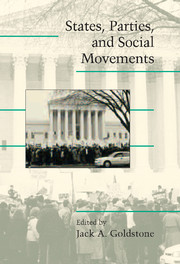Book contents
- Frontmatter
- Contents
- List of Figures and Tables
- Foreword
- Acknowledgments
- Contributors
- INTRODUCTION: BRIDGING INSTITUTIONALIZED AND NONINSTITUTIONALIZED POLITICS
- I States and Social Movements
- 1 COUNTERMOVEMENTS, THE STATE, AND THE INTENSITY OF RACIAL CONTENTION IN THE AMERICAN SOUTH
- 2 STATE VERSUS SOCIAL MOVEMENT: FBI COUNTERINTELLIGENCE AGAINST THE NEW LEFT
- 3 SETTING THE STATE'S AGENDA: CHURCH-BASED COMMUNITY ORGANIZATIONS IN AMERICAN URBAN POLITICS
- 4 STATE PACTS, ELITES, AND SOCIAL MOVEMENTS IN MEXICO'S TRANSITION TO DEMOCRACY
- II Parties and Social Movements
- Afterword: Agendas for Students of Social Movements
- References
- Index
4 - STATE PACTS, ELITES, AND SOCIAL MOVEMENTS IN MEXICO'S TRANSITION TO DEMOCRACY
Published online by Cambridge University Press: 26 February 2010
- Frontmatter
- Contents
- List of Figures and Tables
- Foreword
- Acknowledgments
- Contributors
- INTRODUCTION: BRIDGING INSTITUTIONALIZED AND NONINSTITUTIONALIZED POLITICS
- I States and Social Movements
- 1 COUNTERMOVEMENTS, THE STATE, AND THE INTENSITY OF RACIAL CONTENTION IN THE AMERICAN SOUTH
- 2 STATE VERSUS SOCIAL MOVEMENT: FBI COUNTERINTELLIGENCE AGAINST THE NEW LEFT
- 3 SETTING THE STATE'S AGENDA: CHURCH-BASED COMMUNITY ORGANIZATIONS IN AMERICAN URBAN POLITICS
- 4 STATE PACTS, ELITES, AND SOCIAL MOVEMENTS IN MEXICO'S TRANSITION TO DEMOCRACY
- II Parties and Social Movements
- Afterword: Agendas for Students of Social Movements
- References
- Index
Summary
Theories of democratic transitions as pacts among elites build on the elite paradigm and on theories of the authoritarian state. Juan Linz (1975) conceived of the authoritarian state as a type of political regime intermediate between democracy and totalitarianism. Authoritarian states have limited, nonresponsible political pluralism and no independent political mobilization (Linz 1975, p. 264). State elites are considered the main, if not the only, consequential actors. They are responsible for limiting pluralism by de facto and de jure means, controlling, demobilizing, and repressing challengers. From that perspective, it is not surprising that the “pact school” (Burton and Higley 1987; Diamond and Linz 1989; Higley and Gunther 1992; O'Donnell and Schmitter 1986; Przeworski 1990, 1991) explains democratization as a result of pacts among elites – the main, if not the only, consequential actors. Thus, analysis of rational decision making among elites suffices for the interpretation of contentious events and makes irrelevant the study of social movements since they are either inconsequential or manipulated.
The Mexican transition to democracy departs from the pact-school model in a number of ways. Transitions have usually been from nonelected authoritarian governments to elected representative governments, but Mexico's transition to democracy did not mean merely the establishing or reintroduction of parties and elections: Elections for president and Congress have taken place regularly since 1920. Transitions have usually been sudden events, but the Mexican transition has been a gradual and erratic process; it started in the 1970s and it took almost three decades to come to term.
- Type
- Chapter
- Information
- States, Parties, and Social Movements , pp. 107 - 144Publisher: Cambridge University PressPrint publication year: 2003
- 8
- Cited by



